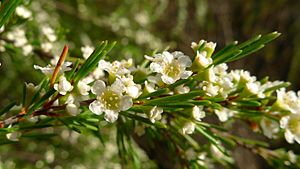Swamp baeckea facts for kids
Quick facts for kids Swamp baeckea |
|
|---|---|
 |
|
| Scientific classification | |
| Genus: |
Baeckea
|
| Species: |
linifolia
|
| Synonyms | |
|
Baeckea linifolia Rudge f. linifolia |
|
Baeckea linifolia is a special plant known as swamp baeckea or weeping baeckea. It's a type of shrub that grows in heathland areas. You can find it in three states in Australia: New South Wales, Queensland, and Victoria. In Victoria, it's quite rare. This shrub can grow up to 1.5 meters tall, and sometimes even up to 3 meters! It likes damp spots, often near waterfalls or in small valleys called gullies. You'll usually see it along the coast and in nearby mountain ranges.
Contents
What Does Baeckea linifolia Look Like?
Baeckea linifolia is a shrub that stands upright. Its branches often have tips that droop downwards, like they are weeping.
Leaves and Flowers
The leaves are long and narrow, like tiny lines. They are spaced out along the stem. Each leaf is about 5 to 15 millimeters long. They are pointed at the end and get narrower towards the base.
The flowers are white and grow one by one. They are found where the leaves meet the stem. Each flower is about 5 millimeters wide. They sit on small stems that are about 1.5 to 2 millimeters long. The petals are shaped like an egg and are 1.5 to 2.5 millimeters long. Inside the flower, there are 8 to 15 stamens, which are the parts that make pollen.
Fruit and Seeds
After flowering, the plant produces a fruit. This fruit is shaped like a small cup. Inside, the seeds have sharp edges.
When Does It Flower?
In Victoria, this plant usually flowers from December to March. In the Sydney area, it mostly flowers in January and February.
Where It Grows
In Victoria, you can find Baeckea linifolia in low, swampy heathlands. It grows mainly from Cann River towards the east and north. Plants in Victoria often have smaller, stiffer leaves. This is different from the plants found in New South Wales and Queensland.
How Baeckea linifolia Got Its Name
The plant Baeckea linifolia was first officially described in 1807. This was done by a person named Edward Rudge. His description was published in a scientific book called Transactions of the Linnean Society of London. He studied a plant sample found near Port Jackson.
Meaning of the Name
The second part of the plant's name, linifolia, comes from Latin words. "Linum" means "flax," and "folium" means "leaf." So, linifolia means "flax-leaved." This name describes the plant's leaves, which are long and narrow, much like the leaves of a flax plant.

